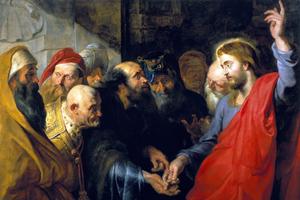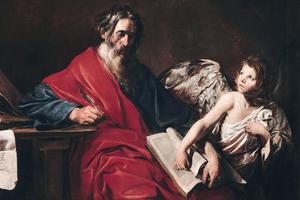Jesus Is Our Great High Priest — What Does That Mean?
Homily for the 29th Sunday in Ordinary Time

Of all feast days and holy days of the year, which one day is the holiest ... to Jews?
Hopefully, before I said “to Jews,” you were thinking of Easter, which, for us, is the solemnity of solemnities, the climax or pinnacle of the whole liturgical year. It’s because of Easter that we’re here today, on the first day of the week, the Lord’s Day, when Christ defeated death and evil and sin.
But which day of the year do Jews celebrate above all?
Maybe you’re wondering why I’m asking this. We all know that understanding our faith is important. But why am I asking about Jewish holy days? Isn’t it enough to know the basics of our own faith? Ah, but here’s the thing: Without at least some understanding of the Jewish world to which Jesus came, and from which the Church was born, we’ll have blind spots regarding our own beliefs and practices, including what happens here in the Mass and what God is saying to us in the readings of his holy word that the Church has chosen to be proclaimed to us today.
Not just Old Testament readings. Today, and every Sunday from now till Christ the King, for five weeks, the second readings are all from one New Testament book: the book of Hebrews. Actually, we’ve been hearing from Hebrews for a couple weeks now, but for these five Sundays the sacred writer explores one supremely important topic: the high priesthood of Jesus.
Jesus, Our Great High Priest
In Jesus, we heard today in the second reading, we have “a great high priest who has passed through the heavens,” who is able to “sympathize with our weaknesses,” having been “tested like us in every way, yet without sin.” In the weeks to come, we’ll hear how every high priest is called to represent the people before God and to offer sacrifices for sins. But the typical high priest has to offer sacrifices first for his own sins and then for those of the people. And he has to keep offering new sacrifices year after year, because these sacrifices don’t actually take away sins. And new high priests are always needed, because men are mortal and they die.
Jesus’ high priesthood, Hebrews tells us, is different. He has no sin to atone for. He offered one sacrifice, himself on the cross, once for all — and that was enough. While the Jewish high priest entered year after year into the Temple sanctuary with the blood of animals, Jesus has entered the true sanctuary, heaven itself, where he lives forever to intercede for us before God. Jesus’ priesthood surpasses the Jewish Levitical priesthood. He is a priest forever in the order of Melchizedek. (What does that mean? Hold that thought.)
This is what we hear for five Sundays starting today concerning Jesus our high priest. If we know nothing about the Jewish Levitical priesthood, all of this will go right over our heads. So what’s going on in these five readings? Why does this matter?
What’s the holiest day of the year for Jews?
Holy of Holies
Maybe some of you are thinking of Passover. Good guess! Not only is Passover a very important Jewish holy day — for us as Catholics, it’s of incomparable importance because of its links to Easter and to the Mass. We can’t understand the Mass if we don’t understand Passover. I would love to talk more about Passover and the Mass — but the readings from Hebrews point me elsewhere.
The holiest day of the year for Jews is not Passover, but Yom Kippur, the Day of Atonement, which falls in autumn. Yom Kippur, the Sabbath of Sabbaths, a day of repentance, fasting and prayer — the climax of the Jewish High Holy Days beginning with the Jewish New Year, Rosh Hashanah, sometime in September.
Yom Kippur, in ancient Israel, was that one day of the year when one person, the high priest, was allowed to enter the Holy of Holies, that inner sanctuary of the house of the Lord — of the Tabernacle in the desert in Moses’ day and the Jerusalem Temple built by King Solomon, the son of David, and rebuilt by the Jews after their return from exile in Babylon. According to Hebrews, the house of the Lord represented all of creation, and the Holy of Holies represented heaven itself.
The Holy of Holies was the traditional resting place of the Ark of the Covenant, the sacred, gold-covered box with the two stone tablets of the Ten Commandments that Moses brought down from Mount Sinai. The Holy of Holies was kept in total darkness, partitioned off from the lesser Holy Place by a heavy curtain. This is the curtain that was ripped in half at the moment of Jesus’ death.
So this one day of the year, Yom Kippur, they would sacrifice a young bull for the sins of the high priest and his household and a goat for the sins of the people, and the high priest would enter the Holy of Holies to burn incense and offer prayer, and to sprinkle the blood of the sacrificed animals. And then the next year they would do it all over again.
Atonement in Christ
Yom Kippur is the background for most of what we hear in the second readings from Hebrews in these five weeks. Jesus is our high priest. His sacrifice — not for his own nonexistent sins, but for our sins — is not the blood of animals, but his own flesh and blood, offered once for all on the cross. He gave his life as an offering for sin, as the prophet Isaiah says in today’s first reading. This is the “cup” he told James and John he had to drink in the Gospel, and the “baptism” he had to be baptized with.
Having made this sacrifice, Jesus didn’t go into the Holy of Holies in the Temple, where the curtain was torn in two. He ascended into the true Holy of Holies, heaven itself, where he offers, not incense, but what incense symbolizes: prayer and intercession, for us, to God the Father.
The book of Hebrews argues that Jesus’ high priesthood is superior to the Jewish Levitical priesthood. The Jewish priests were always from the family of Moses’s brother Aaron, from the tribe of Levi. Jesus wasn’t a Levite. He was a descendant of King David, from the tribe of Judah. So he wasn’t even eligible to be a Levitical priest. That’s why Hebrews looks back to the mysterious figure of Melchizedek in book of Genesis, in the days of Abraham, long before Moses and Aaron. Melchizedek was both king and priest — a royal priesthood foreshadowing the royal priesthood of Jesus. I wish I could say more about Melchizedek, but this homily is already too long, and I have to wrap it up.
So I’ll leave you with this: What’s the point for us? Why does the sacred writer to the Hebrews make this argument in these readings over these five Sundays?
Hold Fast
Hebrews was written first of all for Jewish Christians — Jewish believers who accepted Jesus as the Messiah — but were tempted to go back to the Jewish sacrificial system that our faith teaches has been fulfilled by our Lord. Maybe understandably: Imagine growing up with this magnificent temple and hereditary priesthood spilling the blood of animals according to the law God gave to Moses on Mount Sinai, and then joining a new sect where they don’t do any of that, but they meet in people’s homes and have a ritual meal with bread and wine that they say is far more powerful than the bloody sacrifices on the altar that you can see. On top of other factors, maybe there’s a temptation to return to what was at the time the more impressive-looking religion.
The book of Hebrews argues that everything good about Judaism is perfected in Jesus. He’s not proselytizing non-Christian Jews here; he’s trying to encourage Jewish Christians not to abandon their faith in Jesus. And this is something very relevant in our times. So many Christians, including Catholics, have abandoned faith in Jesus — not for something more impressive-looking, but in many cases for no religion at all.
Their reasons are many and complicated, but often their grievances include actions of clergy or of the hierarchy. And while it’s never a reason to leave the faith, often their grievances are valid, and may God have mercy on those, especially those in Holy Orders, who put obstacles between people and God. For instance, clergy who are more like the Gentile rulers Jesus talked about in today’s Gospel, making their authority felt, than the servants he calls them to be.
The writer to the Hebrews wants to redirect our gaze away from what we see on earth to our high priest in the heavens, Jesus Christ. I’m not here today for our celebrant (as fond as I am of him). I’m not here for this magnificent building or for the sublime organ music (much as I appreciate them every week). I’m not here for our pastor, our bishop, or our pope (much as I love and honor them all). I’m here for Jesus. By the grace of God, I will always be here for Jesus.
The message of Hebrews over the next five weeks comes down in the end to two words, in today’s reading: Hold fast. “Since we have such a great high priest, Jesus, the Son of God, let us hold fast to our confession. ... Let us confidently approach the throne of grace.”
Lord Jesus, our great high priest, give us all the grace to hold fast. Amen.















